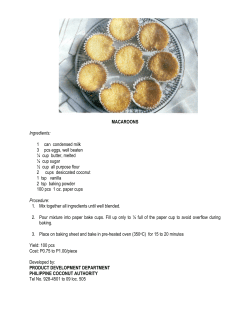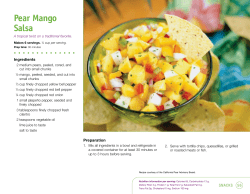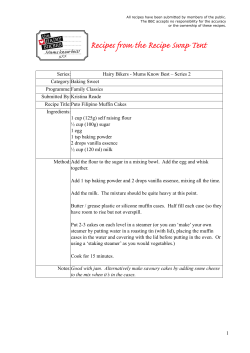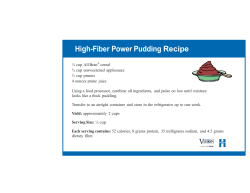
CICADA-LICIOUS: Cooking and Enjoying Periodical Cicadas Created by Jenna Jadin
CICADA-LICIOUS: Cooking and Enjoying Periodical Cicadas Created by Jenna Jadin and the University of Maryland Cicadamaniacs © 2004 University of Maryland 2nd edition Table of Contents Introduction to Entomophagy....……………………………….2 Cooking with Cicadas…………………………………………5 The Recipes: Appetizers and Main dishes……………………………………6 Desserts……………………………………………………….15 Disclaimer and Nutritional Information: The University of Maryland and the Cicadamaniacs do not advocate eating cicadas without first consulting your doctor. While many people worldwide do eat cicadas, there is no guarantee that they are safe for every person to eat. Pesticide and other chemical accumulation is possible, but unless one decides to binge on cicadas, this should not be a concern. Additionally, while they do not contain any toxic substances, the nutritional content is unknown and we ask that you please take special caution if you have other food allergies such as soy, nuts, or shellfish, or if you know of any contact allergies that you may have to other insects. An Introduction to Entomophagy; or, How I Learned to Love the Bug Eating bugs sounds disgusting? If you have ever eaten a crawfish, lobster, crab, or shrimp then you have already eaten members of the class Arthropoda, of which insects are a part. So popping a big juicy beetle, cricket, or cicada into your mouth is only a step away. You have, in fact, probably already eaten many pounds of insects in your lifetime. Most Americans don't realize that they are eating a pound or two of insects each year. This is because insects are a part of all processed foods from bread to tomato ketchup--it's impossible to keep mass-produced food 100% insect-free. There are regulations stating the maximum amount of bug bits that food can contain and still be fit for human consumption. These bits, unseen, have been ground up into tiny pieces in such items as strawberry jams, peanut butter, spaghetti sauce, applesauce, frozen chopped broccoli, etc. For example, the “Food Defect Action Levels”, as currently defined by the Food and Drug Administration state that macaroni and noodle products can have 225 or more insect parts per 225 grams of product (4). This may sound disgusting, but these insect parts actually make some food products more nutritious. Many people all over the world eat insects and other arthropods both as a delicacy and staple. This is sensible because insects are nutritious. Insects provide as much protein pound per pound as lean beef. For example, every 100 gram serving of each, termites provide 617 calories of energy while lean ground beef gives 219 and cod gives 170 (3). Although their amino acid content is not as well-balanced for human nutrition, this can be easily corrected by including fiber and other plant proteins into your diet. Insects are also a good source of minerals and some vitamins, especially for people who have limited access to other animal proteins. Overall, over 1,000 insect species are eaten by humans (2). Archaeological evidence tells us that entomophagy has been practiced since mankind first made an appearance on this planet. It would appear that all are edible though--some insects are toxic and may cause allergic of insects. For those of us that are watching our waistlines, it is worth noting that they are low in fat and cholesterol. And finally, they are far cleaner in their own eating habits than other creatures: grasshoppers and crickets eat fresh, clean, green plants whereas crabs, lobsters and catfish eat any kind of foul, decomposing material. reactions —so one needs to be careful about what they are consuming. Here are just a few examples of insects that are eaten around the world: • Witchetty Grub is the caterpillar of the large Cossid Moth (Xyleutes leucomochla Turn) which lives inside and feeds on acacia stems and roots. Eaten raw by Australian aborigines, they are said to taste of almonds. Ten large grubs provide all the calories, protein and fat that an adult human needs in a day (1). • The people of Zaire eat more than 35 different types of caterpillars, usually toasted or sautéed in butter. In parts of Africa where winged termites emerge in dense numbers, they are eagerly collected. They emerge with the first rains at the end of the dry season when the people are weak from malnutrition. They are either fried, roasted and eaten salted, or ground into flour. In Nigeria, stock cubes based on termites are easily available (2). • Dragonflies and damselflies are hunted and eaten in Bali. They are caught with a sticky stick and then eaten grilled, or boiled with spices. • Filipino farmers flood their fields to capture mole crickets that are sold to restaurants. • In Mexico, chocolate covered bees and bees in syrup are canned and sold and exported as a gourmet item. • Sago grubs are popular for cooks in Papua New Guinea, most often boiled or roasted over an open fire. • In India and Indochina, a paste of green weaver ants is a spicy condiment. These ants also spice up rice in Borneo and is made into a drink in Australia. • You can buy deep fried Giant Water Bugs at streetside stalls in Thailand. An extraction of its abdominal glands are used to flavor many Thai dishes. • And finally, wasps have the highest protein content of all edible insects (80%) and the larva is food in rural parts of Thailand and Laos. Fried wasps, mixed with boiled rice, sugar, and soy sauce was a favorite dish of Emperor Hirohito of Japan. The benefits to eating insects are numerous, as many of these societies have discovered. Most insects are a cheap, tasty protein source, that requires less land area and feed than cows or pigs. For example, one hectare of US ranch land supports 100kg of beef, but can support 1 ton Fifty years ago, it was common for an apple to have worms inside, bean pods with beetle bites, and cabbage with worm eaten leaves. While this might seem initially unappealing to the average consumer, the consequence was that fewer pesticides were used on these products, making them an overall much safer and healthier food to eat. If Americans could tolerate more insects in what they eat, the U.S. Food and Drug Administration could relax the limit for insects and their parts in food crop. This would allow farmers to significantly reduce the amount of pesticides applied to their crops each year. And I am sure that you would agree that it is far better to eat more insects and less pesticide residue! Acknowledgements and Further Information: U 1. Arthropods for Breakfast: http://www.szgdocent.org/ff/f-arth3c.htm HTU UTH 2. How to Use Insects as Food: http://members.aol.com/keninga/insects.htm HTU UTH 3. The Ohio State University Factsheet: http://ohioline.osu.edu/hyg-fact/2000/2160.html HTU UTH 4. The FDA Food Defect Action Levels http://vm.cfsan.fda.gov/~dms/dalbook.html HTU U UTH Cooking “with” cicadas A staple food in the past for Australian Aborigines, New Guineans, Siamese people, and American Indians, cicadas were considered a special delicacy in ancient Greece and Rome, as well as modern-day Japan. They contain a high protein content, and since cicadas eat only vegetable matter, they are a pure and wholesome food source. Additionally, they are said to be tasty, having a delicate nutty flavor. Who to cook: newly hatched cicadas, called tenerals, are considered best for eating because their shells have not hardened. It is best to collect these in the very early hours of the morning, just after they have emerged, but before they have time to climb up out of reach. The best way to do this is to simply go outside with a brown paper bag and starting scooping them in. They should be blanched (boiled for 4-5 mintues) soon after collection and before you eat them! Not only will this make their insides solidify a bit, but it will get rid of any soil bacteria that is living on or in them. You can then cook with them immediately, or freeze them. Keep in mind that freezing them will work best for those that you are going to roast, as the consistency of the cicada may change and make them inappropriate for dishes which call for fresh cicadas. If you are unable to get any tenerals, then mature females are the next best thing. Adult males have very hollow abdomens and will not be much of a mouthful, but the females are filled with fat. Just be sure to remove all the hard parts, such as wings and legs before you use the adults. These parts will not harm you, but they are also not very tasty. When the recipe calls for dry-roasted cicadas: place cicadas on cookie sheet and roast for 10 to 15 minutes at 225F. Cooking time will vary depending upon size and water levels. Check your cicadas when you remove them from the oven. They should be a soft dry consistency, a bit like a nut. If they are still moist inside, they should be roasted for longer. When dry grind coarsely and use as nut substitute in bread or on ice cream. A finer grind can be mixed 50:50 with flour to make a highprotein dough. And now for the recipes… Soft-Shelled Cicadas Ingredients: 1 cup Worcestershire sauce 60 freshly emerged 17 year cicadas 4 eggs, beaten 3 cups flour Salt and pepper to season flour 1 cup corn oil or slightly salted butter Directions: Marinate cicadas, alive in a sealed container, in Worcestershire sauce for several hours.* Dip them, in beaten egg, roll them in the seasoned flour and then gently saute them until they are golden brown. Yield: 4 main dish servings *this step may be skipped and you may go directly to the egg step instead. Shanghai Cicadas Cicada Dumplings Ingredients: 30 newly-emerged cicadas 2 tbps anise seeds 1 tsp salt 2 cups sherry 1tbsp soy sauce additional water and sherry or rice wine 10 cloves mashed garlic celery to garnish turnip greens to garnish Ingredients: Directions: 1. Boil the cicadas and anise in salted sherry for five minutes, then remove the cicadas. 2. Saute the mashed garlic and soy sauce, adding enough of equal parts water and sherry to make a thick paste. 3. Deep-fry the cicadas, then skewer them with bamboo picks. Arrange them on a plate with the turnip greens, celery, and garlic paste to look like cicadas climbing out of a mud pie into green foliage. Yield: 4 appetizer-sized servings 20 Chinese black mushrooms, soaked and destemmed 6 egg whites 4 oz cicadas, wings removed and pre-boiled for 5 minutes 1/2 oz cooked Chinese ham, cut into 1"-long, 1/16"-thickstrips 1/2 tsp cornstarch 1 tsp salt 3/4 tsp MSG (optional) 2 cups chicken broth Directions: 1. Mince 2 oz cicadas and 1 oz fat pork separately, then mix in bowl. Add 1/8 tsp salt and 1/4 tsp MSG. Stir until firm. Divide into 10 portions for mushroom stuffing. 2. Squeeze excess water from mushrooms. Put in bowl, add a little broth and steam for 30 minutes. Remove and squeeze out excess liquid. Place in dish, stem sides up, and sprinkle with cornstarch. Place one portion cicada stuffing in middle of a mushroom and cover with another mushroom, black side up, to make a stuffed mushroom pouch. Repeat until 10 pouches are done. 3. Mince remaining pork and cicadas separately, then mix in a bowl. Add 1/4 tsp salt and 1/2 tsp MSG. Stir until firm. Make 20 balls in the shape of a cicada. Beat egg whites. Grease pan. Make a thin small round pancake with one tbsp egg white. Place a cicada ball in the middle and wrap pancake around. Pinch ball to form head and body of the cicada. Fry for 1/2 minute and remove. Put two strips ham in head. Repeat until 20 “cicadas” are made. Put mushroom pouches and shrimp cicadas on plate. Steam for one minute over high heat. Remove and place separately in fureen. Bring stock to boil and add remaining salt. Pour stock slowly into fureen and serve. Yield: Serve 4 to 6. Cicada Stir-Fry Maryland Cicadas Ingredients: Ingredients: 1 onion, minced 2 tbsps fresh coriander (cilantro), chopped 1 tbsp fresh gingerroot, minced 3/4 cup sliced carrots 3/4 cup chopped cauliflower and/or broccoli 1 can water chestnuts 3/4cup bean sprouts 3/4cup snow peas 40 blanched teneral cicadas 1/2 cup Old Bay® Seasoning 2 tablespoons salt 4 quarts water 1 (12 fluid ounce) can beer (optional) 8 red potatoes, quartered 2 large sweet onions, cut in wedges 2 pounds lean smoked sausage, cut in 2-inch lengths 8 ears fresh corn, broken in half 4 pounds large cicadas Directions: 1. Capture cicadas at night as they emerge from the ground. Blanche for 1 minute in boiling water. They can now be stored in freezer or used immediately in recipes. 2. In a wok or other suitable pan, heat a couple tablespoons of vegetable oil. Add ingredients in the order listed above when those in the most recent addition are partially cooked. 3. Serve over whole-grain rice and add soy sauce to taste Directions: 1. In an 8-quart pot, bring Old Bay, salt, water and beer to a boil. Add potatoes and onions; cook over high heat for 8 minutes. 2. Add smoked sausage to potatoes and onions; continue to cook on high for 5 minutes. Add corn to pot; continue to boil for 7 minutes. Add cicadas, cook for 5 minutes. 3. Drain cooking liquid. Pour contents of pot into several large bowls, shallow pails or mound on a paper-covered picnic table. Sprinkle with additional Old Bay if desired. Yield: 4 main course servings Yield: 8 servings El Chirper Tacos Cica-Delicious Pizza* Ingredients: Ingredients: 3 cloves garlic, pressed 3 tbsp. extra virgin olive oil 2 tbsp. chopped fresh oregano 2 tbsp. chopped fresh basil 2 tbsp. chopped fresh italian parsley 4 cups chopped tomatoes, including juice and seeds 2 tablespoons butter or peanut oil 1/2 pound newly-emerged cicadas 3 serrano chilies, raw, finely chopped 1 tomato, finely chopped 1 onion, finely chopped 1/2 tsp ground pepper or to taste 1/2 tsp cumin 3 tsp taco seasoning mix 1 handful cilantro, chopped Taco shells, to serve Sour cream Shredded cheddar cheese Shredded lettuce Directions: 1. Heat the butter or oil in a frying pan and fry the cicadas for 10 minutes, or until cooked through. 2. Remove from pan and roughly chop into 1/4 inch cubes. Place back in pan. 3. Add the chopped onions, chilies, and tomato, and season with salt, and fry for another 5 minutes on medium-low heat. 4. Sprinkle with ground pepper, cumin, and oregano, to taste. 5. Serve in taco shells and garnish with cilantro, sour cream, lettuce, and cheddar cheese . Yield: 2 main course servings 1 1/2 cup coarsely chopped shittake mushrooms 3/4 cup coarsely chopped red onion 3/4 cup kalamata olives, chopped 1 1/2 cups blanched cicadas 1 cup feta cheese 1 cup mozzarella cheese 1 recipe of your favorite pizza dough (for a 12” pizza) Directions: 1. Heat oil in sauté pan over medium low heat. Add the garlic and sauté for 2 minutes, or until just beginning to turn golden. 2. Add the herbs and cook for another minute, until wilted. 3. Add the tomatoes and juice, turn the heat to low, and gently cook, covered, for 10-15 minutes until the tomatoes are soft and the liquid had been absorbed and the sauce has thickened. Remove from heat. 4. Meanwhile, prepare the dough by rolling it out to desired thickness and shaping it into a 12” circle. Using a shallow wooden spoon, spread the tomato sauce over the pizza dough to the desired thickness. 5. Distribute the rest of the ingredients evenly over the top of the pizza. 6. Place pizza in a 375F oven for 15 minutes, or until the top is bubbling and the crust is golden brown. Yield: Enough for 2-3 hungry cicada-maniacs *change any of the ingredients to suit your personal taste The Simple Cicada Sizzling Chili Cicadas Don’t want to bother cooking up something fancy just to enjoy the delicious taste of the cicada?? Well here is a quick and easy main dish recipe that should take only minutes to prepare: Ingredients: 5 tbsp. soy sauce 5 tbsp. Chinese rice wine or dry sherry 3 dried red chili’s, seeded and chopped 2 garlic cloves, crushed 2 tsp. grated fresh ginger root 5 tbsp. water 1 lb. parboiled cicadas 1 large bunch spring onions, chopped 2 3/4 oz salted cashews 3 tbsp. vegetable oil 2 tsp. corn powder Ingredients: 2 cups blanched cicadas Butter to sauté Two cloves crushed garlic 2 tbsp finely chopped fresh basil, or to taste Your favorite pasta Directions: 1. Melt butter in sauté pan over medium heat. 2. Add garlic and sauté for 30 seconds. 3. Add basil and cicadas and continue cooking, turning down the heat if necessary, for 5 minutes or until the cicadas begin to look crispy and the basil is wilted. 4. Toss with pasta and olive oil. Sprinkle with parmesan cheese if desired. Yield: 4 servings boiled rice and braised shaved root vegetable slices, to serve Directions: 1. Mix the soy sauce with the Chinese rice wine or sherry, chili’s, garlic, ginger and water in a large bowl. 2. Add the cicadas, spring onions and cashew nuts and mix thoroughly so that they are well coated. Cover tightly and marinate in the refrigerator for at least 2 hours, stirring occasionally. 3. Heat the oil in a preheated wok or large, heavy-based frying pan. Remove the cicadas, spring onions and cashews from the marinade with a slotted spoon and add to the wok or pan, reserving the marinade. Stirfry over high heat from 1-2 minutes. 4. Mix the marinade and the corn powder. Add to the pan and cook for 30 seconds, until the marinade forms a slightly thickened, shiny glaze over the cicada mixture. 5. Transfer the chili prawns to a warm serving dish and serve immediately, with plenty of boiled rice and a selection of vegetables. Yield: 3-4 main course servings Emergence Cookies Southern Cicada Tartlets These should look like cicadas emerging out of a little pile of chunky mud! Thanks to my mother, Shirley Jadin, for letting me, umm, alter, this old family recipe! Ingredients: 1/2 cup shortening 3 eggs 1 1/2 cups sugar 4oz unsweetened chocolate, melted and cooled 2 tsp. baking powder 2 tsp. vanilla 2 cups all purpose flour 1/3 cup sugar 1 beaten egg white 1/2 cup coarsely chopped nuts (optional) about 60 parboiled dry roasted cicadas (roast for only 8 minutes so that they retain some moisture) Ingredients: Crust: 2 cups sifted flour 2-3ozs cream cheese softened 2 sticks butter Directions: 1. In a large bowl, beat shortening with eggs, the 11/2 cups sugar, cooled chocolate, baking powder, and vanilla until well combined, scraping sides of bowl. 2. Gradually stir in flour till thoroughly combined. Stir in the nuts. Cover and chill for 1-2 hours or until dough is easy to handle. 3. Meanwhile, stir together the 1/3 cup sugar and beaten egg white. Place cicadas on waxed paper; brush with egg white mixture and set aside. 4. Shape dough into 1inch balls. Place 2 inches apart on ungreased cookie sheets. Place a cicada on top of each ball, pressing lightly. 5. Bake in a 375 oven for 8-10 minutes or till edges are set. Transfer to a rack to cool. Yield: 60 cookies Mix well and chill overnight. Filling: 3 eggs well beaten 2 cups brown sugar 2 tbs melted butter 2 tsp vanilla 1/2 cup dry roasted cicadas, chopped 1. In ungreased tart tins, put about 1 tsp of crust dough, push around the tin and shape into little pie crust. 2. Fill each tart 1/2 full of filling. 3. Bake at 350 for 25 to 30 Minutes. 4. Immediately after removing from oven, place a single dry-roasted cicada in the center of each tart. Yield: 55 tartlets Banana Cicada Bread Chocolate-Chip Trillers Ingredients: Ingredients: 1/2 cup shortening 3/4 cup sugar 2 bananas, mashed 2 cups flour 1 teaspoon soda 1 teaspoon salt 1/2 cup chopped nuts 2 eggs 1/4 cup dry-roasted cicadas 2-1/4 cups flour 1 tsp. baking soda 1 tsp. salt 1 cup butter, softened 3/4 cup sugar 3/4 cup brown sugar 1 tsp. vanilla 2 eggs 1 12-ounce pkg. chocolate chips 1 cup chopped nuts 1/2 cup dry-roasted chopped cicadas Directions: Mix together all ingredients. Bake in greased loaf pan at 350 deg F for about one hour. Yield: 1 loaf Directions: 1. Preheat oven to 375 deg F. 2. In small bowl, combine flour, baking soda and salt; set aside. 3. In large bowl, combine butter, sugar, brown sugar and vanilla; beat until creamy. Beat in eggs. 4. Gradually add flour mixture and insects, mix well. Stir in chocolate chips. 5. Drop by rounded measuring teaspoonfuls onto ungreased cookie sheet. 6. Bake for 8-10 minutes. Yield: Approximately 3 dozen cookies Cicada-Rhubarb Pie Chocolate Covered Cicadas Ingredients: My favorite: very simple, very tasty! 4 cups chopped rhubarb 1 cup fresh cicadas, washed and any hard parts removed 1 1/3 cups white sugar 6 tablespoons all-purpose flour 1 tablespoon butter 1 recipe pastry for a 9 inch double crust pie Ingredients: Directions: 1. Preheat oven to 450 degrees F (230 degrees C). 2. Combine sugar and flour. Sprinkle 1/4 of it over pastry in pie plate. Heap rhubarb over this mixture. Sprinkle cicadas in amongst the rhubarb. Sprinkle with remaining sugar and flour. Dot with small pieces of butter. Cover with top crust. 3. Place pie on lowest rack in oven. Bake for 15 minutes. Reduce oven temperature to 350 degrees F (175 degrees C), and continue baking for 40 to 45 minutes. Yield: Makes 1 pie (8 servings). 8 squares of good-quality dark, white, or milk chocolate 30 dry roasted cicadas Directions: 1. Roast teneral cicadas for 15 minutes at 225F. 2. Meanwhile, melt chocolate in a double-boiler over low heat. Dip insects in chocolate, place on wax paper and refrigerate until hardened. Yield: 30 cicadas
© Copyright 2025








